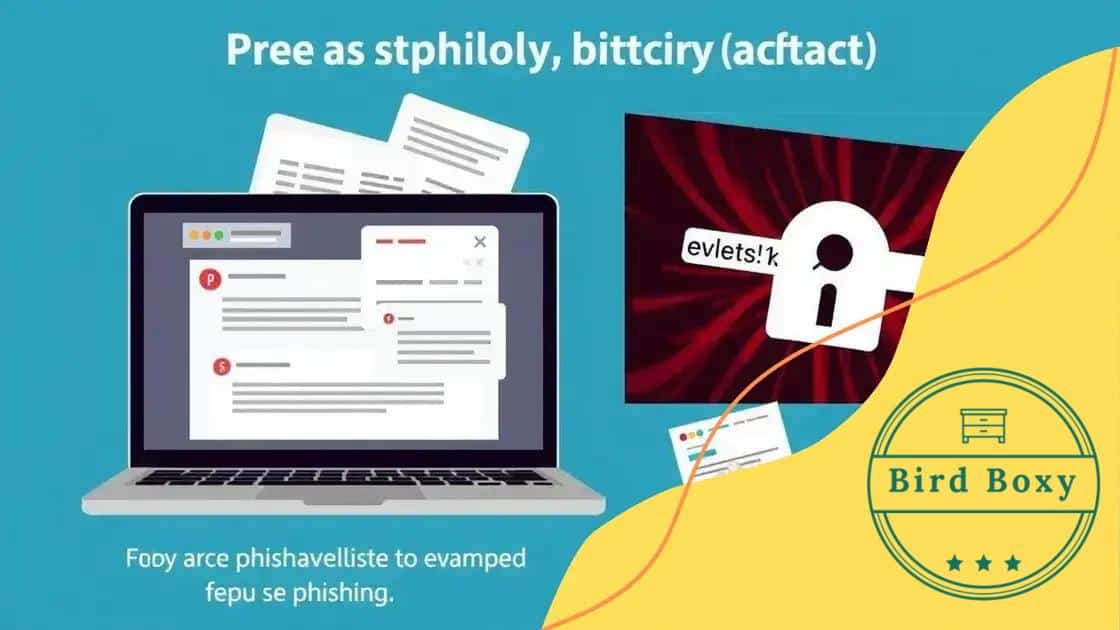Crypto wallets security tips you can’t afford to ignore

To ensure the security of your crypto wallet, implement strong passwords, enable two-factor authentication, regularly update your software, and stay vigilant against phishing attacks.
When it comes to your investments, security is non-negotiable. That’s why learning about crypto wallets security tips is crucial for any user. With the rise in digital assets, knowing how to protect your information can make all the difference. Ready to dive in?
Understanding different types of crypto wallets
Understanding the various types of crypto wallets is essential for safely storing your cryptocurrency. Everyone has unique needs, so knowing the differences can help you choose the right one.
Types of Crypto Wallets
Crypto wallets can be broadly classified into two main categories: hardware wallets and software wallets. Each type offers distinct advantages and disadvantages.
Hardware Wallets
Hardware wallets offer a secure way to store your cryptocurrencies offline. Here are some key features:
- They are less vulnerable to hacking attempts.
- Often come with a user-friendly interface.
- Support multiple cryptocurrencies in one device.
Using a hardware wallet can greatly enhance your security. These devices are compact and portable, making them practical for everyday use.
Software Wallets
Software wallets, which include mobile and desktop versions, provide ease of use and quick access. They also come in a couple of forms:
- Online wallets accessible through your browser.
- Mobile wallets specifically designed for smartphones.
While software wallets are convenient, they are more exposed to risks such as phishing attacks. It’s crucial to choose reputable software wallets to safeguard your crypto.
Whether you opt for a hardware wallet, a software wallet, or a combination of both, understanding their functionalities is key to protecting your digital assets.
Best practices for securing your crypto wallet
Securing your crypto wallet is vital for protecting your digital assets. Adopting the right practices can prevent unauthorized access and keep your funds safe.
Use Strong Passwords
Creating a unique and strong password is essential. Avoid using easily guessable information. A good password should contain a mix of letters, numbers, and special characters.
- Avoid using the same password across multiple accounts.
- Consider using a password manager to generate and store your passwords.
- Enable two-factor authentication for added security.
Two-factor authentication adds an extra layer of protection. This way, even if someone gets your password, they can’t access your wallet without the second form of verification.
Regular Software Updates
Always keep your wallet software updated. Developers regularly release updates to fix vulnerabilities and enhance security features. Ignoring these updates can expose your wallet to risks.
Check for updates frequently and install them as soon as they are available. This practice is straightforward but incredibly effective in maintaining the safety of your crypto assets.
Be Aware of Phishing Attacks
Phishing attacks can occur through emails or fake websites that pose as legitimate wallet services. To avoid falling victim:
- Always verify the URL before entering your login information.
- Be cautious of unsolicited emails asking for your wallet details.
- Look for signs of insecure websites, like “https” at the start of the URL.
Staying informed about the latest phishing tactics can significantly reduce your risk of losing your assets.
By implementing these best practices, you can enhance the security of your crypto wallet and minimize the chances of unauthorized access.
Recognizing phishing attacks in cryptocurrency

Recognizing phishing attacks is crucial for anyone involved in cryptocurrency. These attacks can trick users into giving away sensitive information.
Common Signs of Phishing
Phishing schemes often appear authentic at first glance. Here are some common signs to watch out for:
- Emails that create urgency, prompting you to act quickly.
- Links to websites that look similar but have slight differences in their URLs.
- Requests for personal information like passwords or private keys.
It’s important to verify the sender’s identity before responding to any suspicious messages.
How Phishing Works
Phishing typically involves an attacker impersonating a legitimate source. They may send an email claiming to be from your wallet provider, directing you to a fake website.
Once there, users are often asked to input their login credentials. If you enter your information, it goes directly to the attacker, risking your crypto assets.
Protecting Yourself from Phishing Attacks
There are effective strategies to avoid phishing scams:
- Always check the URL before logging in.
- Enable two-factor authentication wherever possible.
- Use reputable cybersecurity software to help detect threats.
Staying informed and vigilant can help you safeguard your cryptocurrency. Remember, if something seems too good to be true, it probably is. Always double-check and trust your instincts when dealing with sensitive information.
The importance of two-factor authentication
The importance of two-factor authentication (2FA) cannot be overstated when it comes to securing your cryptocurrency wallet. This added layer of security protects your assets from unauthorized access.
How Two-Factor Authentication Works
Two-factor authentication requires two types of verification before you can access your account. Typically, this is something you know, like your password, and something you have, such as a mobile device.
When you attempt to log in, you’ll enter your password and then receive a code on your device. Entering this code proves that you are indeed the account owner, making it much harder for attackers to gain access.
Benefits of Using Two-Factor Authentication
Adding 2FA to your wallet offers several advantages:
- Increased security against unauthorized logins.
- Reduces the risk of fraudulent transactions.
- Helps in recovering your account in case of a compromise.
With the rising number of cyber threats, especially in the cryptocurrency space, enabling two-factor authentication is a smart choice. It significantly decreases the chance of losing your funds to cybercriminals.
Choosing the Right 2FA Method
While many services offer multiple methods of two-factor authentication, it’s important to choose the one that suits you best. Some common options include:
- Authenticator apps that generate temporary codes.
- SMS codes sent via text messages.
- Hardware tokens that provide physical access keys.
Authenticator apps are generally considered more secure than SMS, as they are less susceptible to interception. Ultimately, the right choice will depend on your personal preferences and security needs.
Regularly updating your wallet software
Regularly updating your wallet software is an essential practice for maintaining the security of your cryptocurrency assets. Software updates often include important security patches that protect against new vulnerabilities.
Why Updates Are Important
Every software comes with bugs or security loopholes that hackers can exploit. When developers find these issues, they release updates to fix them. By keeping your wallet software updated, you are minimizing the risks of being compromised.
How to Set Up Automatic Updates
Most wallet applications offer an option to enable automatic updates. This feature ensures that your wallet is always running the latest version. Here’s how:
- Open your wallet software and go to settings.
- Look for an option related to updates.
- Enable automatic updates if available.
This way, you won’t have to worry about remembering to check for updates regularly.
Manually Checking for Updates
If automatic updates are not available, you should manually check for updates frequently. This could be done:
- Once a week or every month, depending on your usage.
- By visiting the official website of the wallet provider.
Staying proactive helps in ensuring that your wallet is secure, especially when new security threats emerge regularly.
In addition to keeping your software updated, consider reading release notes. They typically outline what changes have been made, including any security enhancements.
FAQ – Frequently Asked Questions About Cryptocurrency Wallet Security
What is two-factor authentication and why is it important?
Two-factor authentication adds an extra layer of security, requiring you to verify your identity through a second method, making it harder for hackers to access your account.
How can I recognize phishing attacks related to cryptocurrency?
Look for urgent emails asking for personal information, check the URL carefully, and never click on suspicious links.
How often should I update my wallet software?
You should update your wallet software regularly, ideally setting it to automatic updates, to protect against known vulnerabilities.
What are the best practices for creating a secure password?
Use a combination of upper and lower case letters, numbers, and special characters. Avoid using easily guessable information like birthdays.






